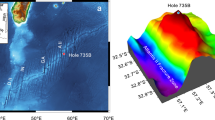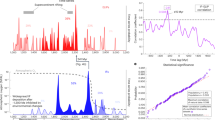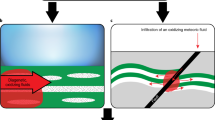Abstract
Iron formations are chemical sedimentary rocks comprising layers of iron-rich and silica-rich minerals whose deposition requires anoxic and iron-rich (ferruginous) sea water. Their demise after the rise in atmospheric oxygen by 2.32 billion years (Gyr) ago1 has been attributed to the removal of dissolved iron through progressive oxidation2 or sulphidation3,4 of the deep ocean. Therefore, a sudden return of voluminous iron formations nearly 500 million years later poses an apparent conundrum3,5. Most late Palaeoproterozoic iron formations are about 1.88 Gyr old6,7,8 and occur in the Superior region of North America5,9,10. Major iron formations are also preserved in Australia, but these were apparently deposited11 after the transition to a sulphidic ocean at 1.84 Gyr ago that should have terminated iron formation deposition4, implying that they reflect local marine conditions5,12. Here we date zircons in tuff layers to show that iron formations in the Frere Formation of Western Australia are about 1.88 Gyr old, indicating that the deposition of iron formations from two disparate cratons was coeval and probably reflects global ocean chemistry. The sudden reappearance of major iron formations at 1.88 Gyr ago—contemporaneous with peaks in global mafic–ultramafic magmatism13,14, juvenile continental and oceanic crust formation15,16, mantle depletion17,18 and volcanogenic massive sulphide formation5,19—suggests deposition of iron formations as a consequence of major mantle activity and rapid crustal growth5,10,15,20. Our findings support the idea that enhanced submarine volcanism and hydrothermal activity linked to a peak in mantle melting released large volumes of ferrous iron and other reductants that overwhelmed the sulphate and oxygen reservoirs of the ocean, decoupling atmospheric and seawater redox states, and causing the return of widespread ferruginous conditions. Iron formations formed on clastic-starved coastal shelves where dissolved iron upwelled and mixed with oxygenated surface water. The disappearance of iron formations after this event may reflect waning mafic–ultramafic magmatism and a diminished flux of hydrothermal iron relative to seawater oxidants.
This is a preview of subscription content, access via your institution
Access options
Subscribe to this journal
Receive 51 print issues and online access
$199.00 per year
only $3.90 per issue
Buy this article
- Purchase on Springer Link
- Instant access to full article PDF
Prices may be subject to local taxes which are calculated during checkout


Similar content being viewed by others
References
Bekker, A. et al. Dating the rise of atmospheric oxygen. Nature 427, 117–120 (2004)
Holland, H. D. The Chemical Evolution of the Atmosphere and Oceans (Princeton University Press, 1984)
Canfield, D. E. A new model for Proterozoic ocean chemistry. Nature 396, 450–453 (1998)
Poulton, S. W., Fralick, P. W. & Canfield, D. E. The transition to a sulphidic ocean ∼1.84 billion years ago. Nature 431, 173–177 (2004)
Bekker, A. et al. Iron formation: the sedimentary product of a complex interplay among mantle, tectonic, oceanic, and biospheric processes. Econ. Geol. 105, 467–508 (2010)
Findlay, J. M., Parrish, R. R., Birkett, T. C. & Watanabe, D. H. U-Pb ages from the Nimish Formation and Montagnais glomeroporphyritic gabbro of the central New Quebec orogen, Canada. Can. J. Earth Sci. 32, 1208–1220 (1995)
Fralick, P., Davis, D. W. & Kissin, S. A. The age of the Gunflint Formation, Ontario, Canada: single zircon U-Pb age determinations from reworked volcanic ash. Can. J. Earth Sci. 39, 1085–1091 (2002)
Schneider, D. A., Bickford, M. E., Cannon, W. F., Schultz, K. J. & Hamilton, M. A. Age of volcanic rocks and syndepositional iron formations, Marquette Range Supergroup: implications for the tectonic setting of Paleoproterozoic iron formations of the Lake Superior region. Can. J. Earth Sci. 39, 999–1012 (2002)
Gross, G. A. Iron Formation in Canada, Genesis and Geochemistry (Geological Survey of Canada, Open File 5987, 2009)
Isley, A. E. & Abbott, D. H. Plume-related mafic volcanism and the deposition of banded iron formation. J. Geophys. Res. 104, 15461–15477 (1999)
Pirajno, F., Hocking, R. M., Reddy, S. M. & Jones, A. J. A review of the geology and geodynamic evolution of the Palaeoproterozoic Earaheedy Basin, Western Australia. Earth Sci. Rev. 94, 39–77 (2009)
Pufahl, P. K., Hiatt, E. E. & Kyser, T. K. Does the Paleoproterozoic Animikie Basin record the sulfidic ocean transition? Geology 38, 659–662 (2010)
Heaman, L. M., Peck, D. & Toope, K. Timing and geochemistry of 1.88 Ga Molson Igneous Events, Manitoba: insights into the formation of a craton-scale magmatic and metallogenic province. Precambr. Res. 172, 143–162 (2009)
Meert, J. G., Pandit, M. K., Pradhan, V. R. & Kamenov, G. Preliminary report on the paleomagnetism of 1.88 Ga dykes from the Bastar and Dharwar cratons, peninsular India. Gondwana Res. 20, 335–343 (2011)
Condie, K. C. Episodic continental growth and supercontinents: a mantle avalanche connection? Earth Planet. Sci. Lett. 163, 97–108 (1998)
Kemp, A. I. S., Hawkesworth, C. J., Paterson, B. A. & Kinny, P. D. Episodic growth of the Gondwana supercontinent from hafnium and oxygen isotopes in zircon. Nature 439, 580–583 (2006)
Pearson, D. G., Parman, S. W. & Nowell, G. M. A link between large mantle melting events and continent growth seen in osmium isotopes. Nature 449, 202–205 (2007)
Parman, S. W. Helium isotopic evidence for episodic mantle melting and crustal growth. Nature 446, 900–903 (2007)
Franklin, J. M., Gibson, H. L., Jonasson, I. R. & Galley, A. G. Volcanogenic massive sulfide deposits. Econ. Geol. 100th anniversary volume. 523–560 (2005)
Condie, K. C. Continental growth during a 1.9-Ga superplume event. J. Geodyn. 34, 249–264 (2002)
Planavsky, N. et al. Rare earth element and yttrium compositions of Archean and Paleoproterozoic Fe formations revisited: new perspectives on the significance and mechanisms of deposition. Geochim. Cosmochim. Acta 74, 6387–6405 (2010)
Planavsky, N. et al. Iron-oxidizing microbial ecosystems thrived in late Paleoproterozoic redox-stratified oceans. Earth Planet. Sci. Lett. 286, 230–242 (2009)
Rasmussen, B. & Fletcher, I. R. Indirect dating of mafic intrusions by SHRIMP U–Pb analysis of monazite in contact metamorphosed shale: an example from the Palaeoproterozoic Capricorn Orogen, Western Australia. Earth Planet. Sci. Lett. 197, 287–299 (2002)
Rasmussen, B. & Fletcher, I. R. Dating sedimentary rocks using in situ U–Pb geochronology of syn-eruptive zircon in ashfall tuffs 1 mm thick. Geology 38, 299–302 (2010)
Johnston, D. T. Multiple sulfur isotopes and the evolution of Earth’s surface sulfur cycle. Earth Sci. Rev. 106, 161–183 (2011)
Barley, M. E., Pickard, A. L. & Sylvester, P. J. Emplacement of a large igneous province as a possible cause of banded iron formation 2.45 billion years ago. Nature 385, 55–58 (1997)
Planavsky, N. J. et al. Widespread iron-rich conditions in the mid-Proterozoic ocean. Nature 477, 448–451 (2011)
Poulton, S. W., Fralick, P. W. & Canfield, D. E. Spatial variability in oceanic redox structure 1.8 billion years ago. Nature Geosci. 3, 486–490 (2010)
Kump, L. R. & Seyfried, W. E., Jr Hydrothermal fluxes during the Precambrian: effect of low oceanic sulphate concentrations and low hydrostatic pressure on the composition of black smokers. Earth Planet. Sci. Lett. 235, 654–662 (2005)
Addison, W. D. et al. Discovery of distal ejecta from the 1850 Ma Sudbury impact event. Geology 33, 193–196 (2005)
Acknowledgements
This work was funded by an ARC Linkage Grant and the Western Australian government Exploration Incentive Scheme Grant to B.R., I.R.F., J.R.M., C.J.G. and A.M.T. A.B. was supported by a NSERC Discovery Grant. A.M.T. publishes with the permission of the Executive Director of the Geological Survey of Western Australia (GSWA). We thank P. Fralick for comments. Scanning electron microscopy imaging was performed at the Centre for Microscopy, Characterisation and Analysis at the University of Western Australia. Zircon U–Th–Pb analyses were conducted using the SHRIMP ion microprobe of the John de Laeter Centre at Curtin University, Perth, Australia.
Author information
Authors and Affiliations
Contributions
B.R., C.J.G., J.R.M. and A.M.T. collected samples, B.R. and J.R.M. carried out petrography and I.R.F. and C.J.G. performed geochronology. All authors were involved in the writing, design and interpretation of the results.
Corresponding author
Ethics declarations
Competing interests
The authors declare no competing financial interests.
Supplementary information
Supplementary Information
This file contains Supplementary Text, Supplementary Figures 1-10, Supplementary References and Supplementary Tables 1-3. (PDF 1528 kb)
PowerPoint slides
Rights and permissions
About this article
Cite this article
Rasmussen, B., Fletcher, I., Bekker, A. et al. Deposition of 1.88-billion-year-old iron formations as a consequence of rapid crustal growth. Nature 484, 498–501 (2012). https://doi.org/10.1038/nature11021
Received:
Accepted:
Published:
Issue Date:
DOI: https://doi.org/10.1038/nature11021
This article is cited by
-
Iron minerals within specific microfossil morphospecies of the 1.88 Ga Gunflint Formation
Nature Communications (2017)
Comments
By submitting a comment you agree to abide by our Terms and Community Guidelines. If you find something abusive or that does not comply with our terms or guidelines please flag it as inappropriate.



